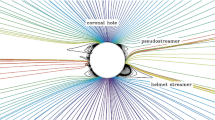Abstract
A theory for the origin of the slow solar wind is described. Recent papers have demonstrated that magnetic flux moves across coronal holes as a result of the interplay between the differential rotation of the photosphere and the non-radial expansion of the solar wind in more rigidly rotating coronal holes. This flux will be deposited at low latitudes and should reconnect with closed magnetic loops, thereby releasing material from the loops to form the slow solar wind. It is pointed out that this mechanism provides a natural explanation for the charge states of elements observed in the slow solar wind, and for the presence of the First-Ionization Potential, or FIP, effect in the slow wind and its absence in fast wind. Comments are also provided on the role that the ACE mission should have in understanding the slow solar wind.
Similar content being viewed by others
References
Fisk, L. A.: 1996, ‘Motion of the Footpoints of Heliospheric Magnetic Field Lines at the Sun: Implications for Recurrent Energetic Particle Events at High Heliographic Latitudes’, J. Geophys. Res. 101, 15547.
Fisk, L. A., Zurbuchen, T. H., and Schwadron, N. A.: 1998, ‘On the Coronal Magnetic Field: Consequences of Large-Scale Motions’, Astrophys. J., in press.
Geiss, J. and Bochsler, P.: 1985, ‘Ion Composition in the Solar Wind in Relation to Solar Abundances’, Rapports Isotopiques dans le Système Solaire 213, Cepadues-Editions, Paris.
Geiss, J., Gloeckler, G., and von Steiger, R.: 1995, ‘Origin of the Solar Wind from Composition Data’, Space. Sci. Rev. 72, 49.
Gloeckler, G., Bedini, P., Fisk, L. A., Zurbuchen, T. H., Ipavich, F. M., Cain, J., Tums, E. O., Bochsler, P., Fischer, J., Wimmer-Schweingruber, R. F., Geiss, J., and Kallenbach, R.: 1998, ‘Investigation of the Composition of Solar and Interstellar Matter Using Solar Wind and Pickup Ion Measurements with SWICS and SWIMS on the ACE Spacecraft’, Space Sci. Rev. 86, 497.
Ko, Y.-K., Fisk, L. A., Geiss, J., Gloeckler, G., and Guhathakurta, M.: 1997, ‘An Empirical Study of the Electron Temperature and Heavy Ion Velocities in the South Polar Hole’, Solar Phys. 171, 245.
Meyer, J.-P.: 1993, ‘Element Fractionation at Work in the Solar Atmosphere’ in Origin and Evolution of the Elements, Cambridge University Press, Cambridge.
Phillips, J. L., Bame, S. J., Feldman, W. C., Goldstein, B. E., Gosling, J. T., Hammond, C. M., McComas, D. J., Neugebauer, M., Scime, E. E., and Suess, S. T. 1995, ‘Ulysses Solar Wind Plasma Observations at High Southerly Latitudes’, Science 268, 1030.
Schwadron, N. A., Fisk, L. A., and Zurbuchen, T. H.: 1998, ‘Elemental Fractionation in the Slow Solar Wind’, Astrophys. J., in press.
von Steiger, R.: 1994, ‘Composition of the Solar Wind’, Habilitation Thesis, University of Bern.
Zurbuchen, T. H., Fisk, L. A., and Gloeckler, G.: 1996, ‘On the Slow Solar Wind (Abstract)’, Eos Trans. AGU 77, Fall Meet. Suppl. F563.
Zurbuchen, T. H., Schwadron, N. A., and Fisk, L. A.: 1997, ‘Direct Observational Evidence for a Heliospheric Magnetic Field with Large Excursions in Latitude’, J. Geophys. Res. 102, 24175.
Author information
Authors and Affiliations
Rights and permissions
About this article
Cite this article
Fisk, L., Schwadron, N. & Zurbuchen, T. On the Slow Solar Wind. Space Science Reviews 86, 51–60 (1998). https://doi.org/10.1023/A:1005015527146
Issue Date:
DOI: https://doi.org/10.1023/A:1005015527146




